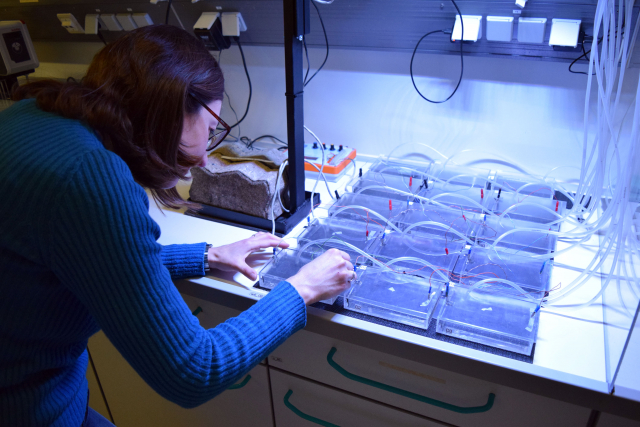11/05/2023 | Federica Rebecchi, a PhD student at the University of Urbino, Italy, is doing a research stay at the ZMT. She is jointly supervised by Christiane Schmidt from ZMT within the DFG funded Project Symbio-AID and Fabrizio Frontalini from the University of Urbino. Her research project focuses on the development of modern biotechnologies for mitigating anthropogenic impact and restoring marine ecosystems.
What is the underlying issue you want to investigate?
Federica Rebecchi: Recent scientific and technological advancements have enabled the implementation of marine biotechnology methods using marine organisms to combat climate change. Our primary question is: Is it possible to stimulate foraminiferal growth by electric current?
Foraminifera are important marine protists with a calcium carbonate shell, which could serve as a tool to restore marine biodiversity in damaged marine habitats. A few studies have documented the positive effects of electric current on calcifying organisms, such as corals, but a research gap exists as to the effects on other organisms, such as Foraminifera.
How exactly are you approaching this question with your experiments in our Marine Aquaculture Facilities?
Federica Rebecchi: The first step is to understand the effects of electrical stimulation on the viability of Foraminifera and their physiology. Even though we hope to be able to stimulate growth, it is important to consider that electric current could also have negative effects. While many marine organisms naturally utilize electric fields for vital life processes, our understanding of how animals, particularly benthic organisms, interact with anthropogenic sources of electric fields remains limited.
What’s happening during the experiment?
Federica Rebecchi: In our current experiment at MAREE, I am using tropical foraminifera from Israel which are invasive species in the Mediterranean and have passed through the Suez Canal. We aim at evaluating the short to medium-term effects of different low electric current densities on the photosynthetic activity of diatom endosymbionts in the model species Amphistegina lobifera, specifically assessing their photosynthetic performance using PAM (Pulse Amplitude modulated) fluorometry.
What do you want to find out?
Federica Rebecchi: The objective is to determine whether the electric current has a positive or negative effect by inducing stress. We focus on analysing the photosynthetic process of benthic foraminiferal species Amphistegina endosymbionts due to the dependence of foraminifera on algal symbionts for growth and calcification.
What are your expectations on the results?
Federica Rebecchi: On the basis of initial experiments in the recent publication by Rebecchi et al. (2023), we anticipate that the very low current values will not have a negative effect on viability. We hope to observe a similar response for photosynthetic activity, but it would be intriguing to discover an increase in photosynthetic activity as well.
What could the expected results mean in the wider picture?
Federica Rebecchi: The expected results would expand our understanding of the interactions between benthic organisms, electric fields, and photosynthetic processes. This knowledge could stimulate further research in the field of marine biotechnology, electrostimulation, and the responses of various marine organisms to anthropogenic sources of electric fields. It would contribute to ongoing scientific discussions and investigations into the potential applications of electric current stimulation in marine ecosystems.
What could be the outcomes of your research?
Federica Rebecchi: If the results of the experiment indicate positive effects of electric current stimulation on foraminiferal specimens, it could potentially contribute to the development of biotechnologies for ecosystem restoration. By enhancing the growth and calcification of foraminifera, these biotechnologies could aid in the recovery of damaged marine habitats, e.g. by growing organisms for reef restoration efforts.
The positive outcomes of my PhD project could lead to the exploitation of benthic foraminifera as an emerging biotechnology that may offer innovative approaches in the development of strategies for restoring aquatic ecosystems at both local and global scales.
Publication
Rebecchi, F.; Lattanzi, D.; Abramovich, S.; Ambrogini, P.; Ciacci, C.; Betti, M.; Frontalini, F. Evaluation of the Effects of Electrical Stimulation: A Pilot Experiment on the Marine Benthic Foraminiferal Species Amphistegina lessonii. Life 2023, 13, 862. https://doi.org/10.3390/life13040862





